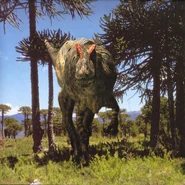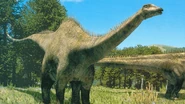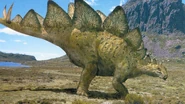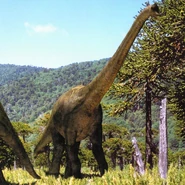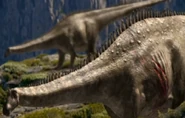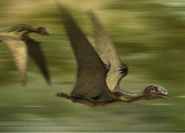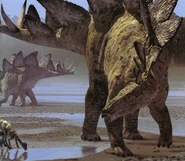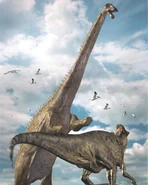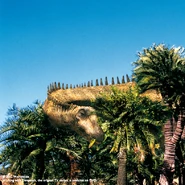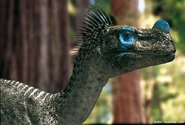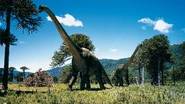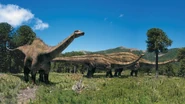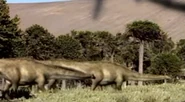| Time of the Titans | ||||||||||||
|---|---|---|---|---|---|---|---|---|---|---|---|---|

| ||||||||||||
| Previous episode New Blood |
Following episode Cruel Sea | |||||||||||
Time of the Titans - broadcast in North America as Jurassic Giants - is the second episode of Walking with Dinosaurs.
Full synopsis
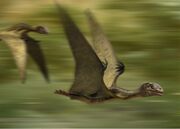
Two Anurognathus.
This episode follows the life of a female Diplodocus, beginning at the moment when her mother lays a clutch of eggs at the edge of a conifer forest. Months later, some of the eggs hatch; the young sauropods are preyed upon by Ornitholestes. After hatching, the hatchlings retreat to the safety of the denser trees. They face many dangers as they grow, including predation by Ornitholestes and Allosaurus. While fending off a pair of Allosaurus, a Stegosaurus also accidentally kills one of the hatchlings while swinging its tail. Elsewhere, adult herds of Diplodocus are shown using their massive weight to topple trees in order to reach cycad leaves. Each Diplodocus hosts a small mobile habitat of damselflies, Anurognathus, and dung beetles. After some time, the creche of Diplodocus have grown into subadults. Nearly all are killed by a huge forest fire; only three survivors emerge onto the open plains, including the young female. They encounter several Brachiosaurus before two reach safety to a herd of adult Diplodocus. Several years later, the female mates, and is attacked by a bull Allosaurus. She is saved when another Diplodocus strikes the Allosaurus with its tail. She rejoins the herd, albeit with deep wounds on her side. The closing narration notes that the sauropods will only get larger, becoming the largest animals ever to walk the Earth.
In the credits it is stated that the sauropods eventually went into decline with their prairies becoming flooded by rising sea levels, resulting in vast inland seas and that the next episode would explore the giant marine reptiles that patrolled them.
Creatures
152 Million Years Ago (Colorado, USA)
- Diplodocus
- Anurognathus
- Dryosaurus (unidentified)
- Ornitholestes (first appearance)
- Stegosaurus
- Allosaurus (first appearance)
- Brachiosaurus (first appearance)
- Damselfly (live acted, first appearance)
- Dung Beetles (live acted, first appearance)
Alternate Versions
- In a rerelease, the following scenes are cut:
- Scene with the mother Diplodocus laying her eggs.
- The introduction to the sauropodlets' forest refuge.
- The scenes that feature the damselflies, the Anurognathus, and the dung beetles.
- The scene where the crèche encounters Diplodocus skeleton.
- The scene where the Diplodocus flattens the forest is shortened.
- The forest fire scene.
Trivia
- This episode features the first feathered animal in the series - Ornitholestes.`
- In the original version there were some lines that were removed in the later version. They can be heard on the 2001 American VHS re-release however.
Gallery
Promotional Images
Errors
- Diplodocus could never reach adulthood in only a decade. The minimum amount of time it would take for Diplodocus to reach adulthood would be twenty to forty years.
- Ornitholestes never had a nasal crest.
- Ornitholestes would have had sickle claws on each of its retractable second toes, similar to a dromaeosaurid. It would have also been feathered, which the companion book depicts.
- Anurognathus lived in Germany, not North America. They were microbat-like insectivores, with no evidence suggesting that they lived a lifestyle similar to modern day oxpeckers. Its anatomy is also very inconsistent with the real animal, with a typically elongated neck, deep skull and small wings
- Allosaurus's anatomy is inconsistent with the real animal, especially concerning the short skull which was a common portrayal at the time due to its incorrect reconstruction.
- The way the Diplodocus lays its eggs in the episode was based on modern turtles, which, like the sauropod in the episode, have ovipositors. But ever since the episode came out, there has been debate about how sauropods laid their eggs without breaking them. It’s now likely that sauropods, including large ones, laid flat on the ground with the cloaca close to the hole in the ground that is being used as a nest.
- Brachiosaurus is stated to weigh 70 tons, and is said to be the largest land animal that has ever existed. However, the largest Brachiosaurus specimen is estimated at 37 tons, with later sauropods such as Argentinosaurus weighing even more. The raised bump on the head is somewhat thin. In reality, the bump had more soft tissue around it. The legs and torso of Brachiosaurus were deeper and taller, and its tail would have been shorter and held higher.
- Contrary to what is said at the end of the episode (“With their passing, life would never again be this large.”), sauropods persisted into the Cretaceous period, flourishing across the globe during the early cretaceous however becoming increasing rare across the globe during the late cretaceous with the exception of South America. Regardless of sauropods, Modern day cetaceans prove that life has indeed reached such sizes again.
- The plates of Stegosaurus were covered in a horny sheath rather than skin, so it could not intimidate predators like Allosaurus by flushing blood into them, as evidenced by the preserved integument impressions of the closely related stegosaurid Hesperosaurus.
- Allosaurus is said to be the top predator of its age. In reality, the top predator of the Morrison Formation at this time was the megalosaurid Torvosaurus, which was larger and heavier than Allosaurus, however not nearly as common.
Broadcast
Original airdate
- 11 October 1999 20.30 BBC One
Repeats
- 12 October 1999 18.30 BBC Choice
- 16 October 1999 20.00 BBC Choice
- 17 October 1999 16.45 BBC One
- 17 October 1999 19.30 BBC Choice
- 4 December 1999 7.30 BBC Knowledge
- 5 August 2000 20.05 BBC One
- 15 January 2003 19.00 BBC Four
- 24 February 2004 1.10 BBC One
- 14 October 2006 19.45 BBC Three

